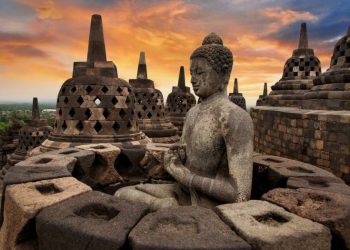Jakarta, IndonesiaSentinel.com — The Joyoboyo Prophecy holds a significant place in Javanese history, culture, and spirituality. It traces its origins to King Joyoboyo of the 12th-century Mataram Kingdom (Kediri).
As one of the most revered figures in ancient Java, King Joyoboyo was known not only for his leadership but for the prophetic visions attributed to him. These prophecies, passed down through generations, have shaped the outlook of many Indonesians and continue to find resonance in modern times.
The Origin of the Joyoboyo Prophecy
King Joyoboyo ruled the Kediri Kingdom (part of the Mataram Kingdom) during the height of its power. His reign was marked by prosperity, stability, and the flourishing of art and literature. However, what set him apart in the annals of Javanese history were the prophecies that were attributed to him. These Joyoboyo Prophecies were a collection of mystical predictions about the fate of the archipelago and its people, focusing particularly on the arrival of a messianic figure known as the Ratu Adil—a “Just King” who would bring peace and justice after a period of chaos.
Key Themes in the Joyoboyo Prophecy
The Joyoboyo Prophecy foretells several key events:
- A Period of Foreign Rule: Joyoboyo predicted that Java and the surrounding regions would be dominated by foreign powers. Many believe this part of the prophecy aligns with the Dutch colonial period that lasted for over three centuries.
- The Emergence of a Great King: According to the prophecy, after a time of great suffering and foreign dominance, a Ratu Adil would emerge to restore balance, justice, and prosperity in the land.
- Signs of the End Times: The prophecy also hints at societal breakdown, with corruption, greed, and immorality taking over before the arrival of this just ruler.
The Role of Ratu Adil
The central figure in the Joyoboyo Prophecy is the Ratu Adil. Many interpretations of the prophecy suggest that this messianic figure would arrive to lead Indonesia (or Java, in particular) out of oppression and into an era of peace and stability. Over the centuries, several leaders, including Sukarno and Suharto, were perceived as fulfilling this prophecy, particularly as Indonesia transitioned from colonial rule to independence.
The Prophecy in Modern Times
The Joyoboyo Prophecy has endured for centuries, shaping the political and cultural landscape of Indonesia. Many still refer to it during times of political or social upheaval, believing that the prophecy’s ultimate fulfillment is yet to come. The idea of a Ratu Adil—someone who can bring justice and balance—resonates deeply, especially in the face of modern challenges such as corruption, inequality, and environmental degradation.
In recent times, the Joyoboyo Prophecy has been invoked in various contexts. Some see parallels between current political leaders and the Ratu Adil, while others believe the prophecy’s ultimate fulfillment lies in the future. Regardless of its interpretation, the prophecy continues to captivate the Indonesian public and serves as a reminder of the nation’s deep-rooted cultural heritage.
Suku Mante, Mysterious Tribe Living in the Vast Forests of Aceh
Conclusion
The Joyoboyo Prophecy is more than just an ancient prediction; it reflects the hopes, fears, and aspirations of a society that has endured periods of hardship and foreign rule. Its themes of justice, leadership, and the quest for a brighter future resonate in modern Indonesia, where people still look to these ancient words for guidance and inspiration. As Indonesia moves forward, the enduring legacy of King Joyoboyo’s vision remains a part of the nation’s cultural fabric.
(Ray)

























